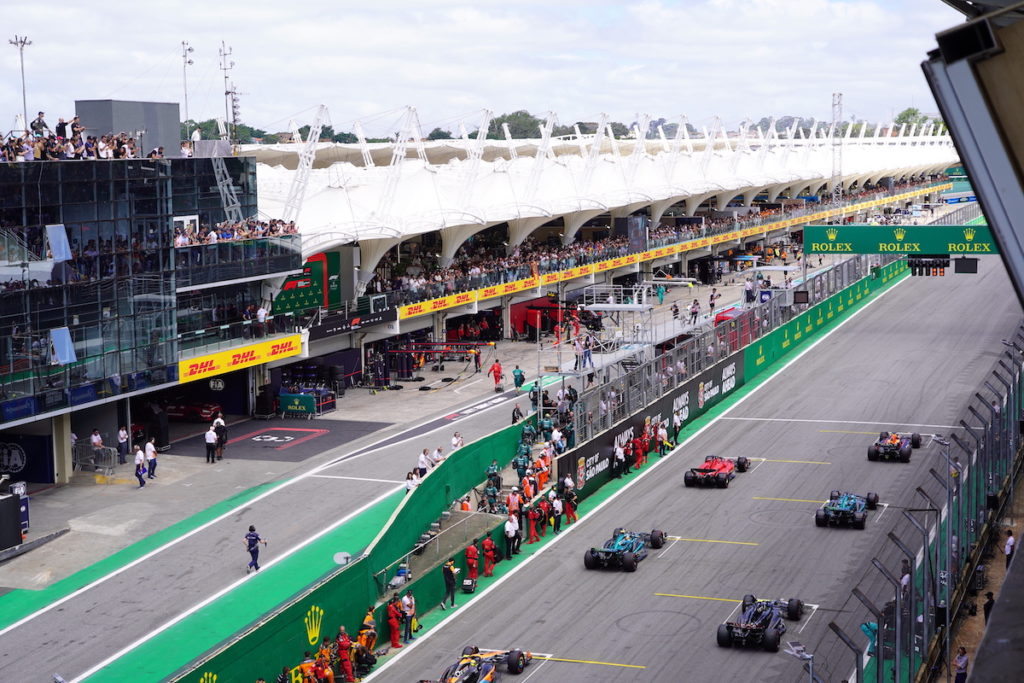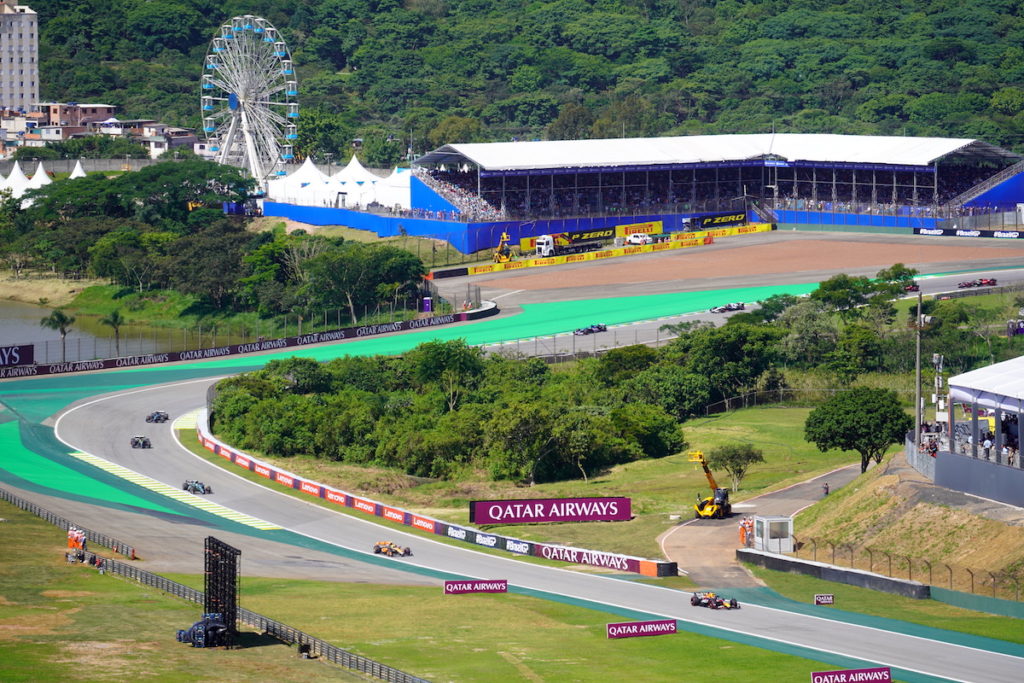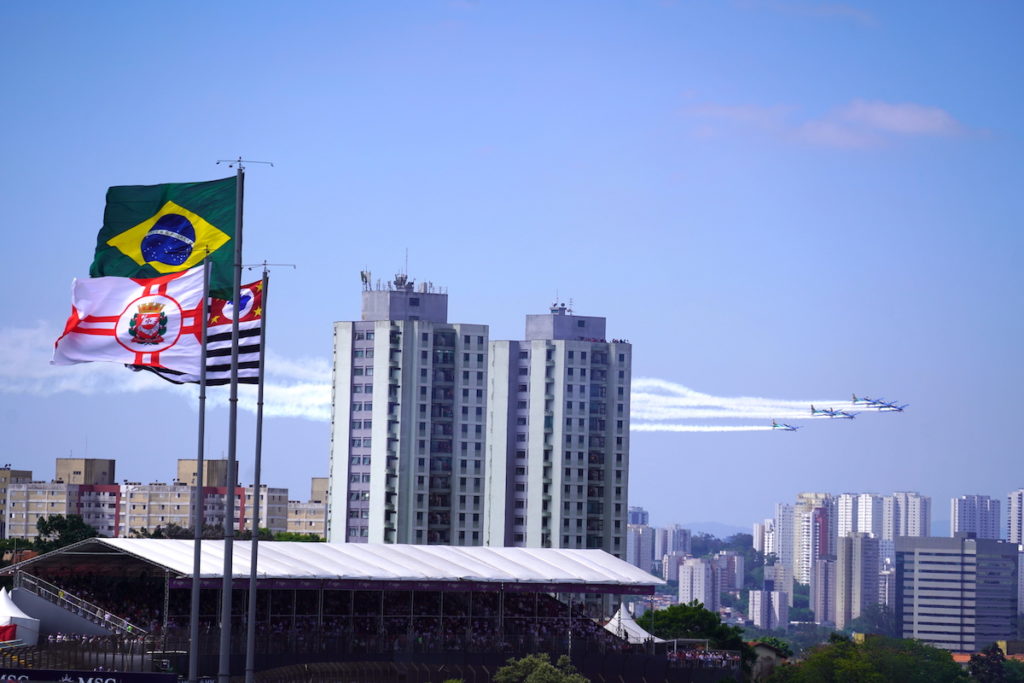
One of Formula 1’s oldest venues, the Brazilian Grand Prix has been on the championship calendar for more than 50 years. The race, now known as the Sao Paulo Grand Prix, is guaranteed to remain on the F1 calendar until at least 2030.
- The 2025 Sao Paulo Grand Prix is scheduled for November 7-9.
- Brazil will stage F1’s sprint race format again in 2025
- This post contains affiliate links. We may receive a commission if you make a purchase after clicking on one of these links
Interlagos was built in 1940, but didn’t begin hosting a regular round of the F1 world championship until 1973. The circuit is located in the Sao Paulo suburb of Interlagos, which literally translates in Portugese as ‘between the lakes’. Even though the circuit was renamed Autodromo José Carlos Pace in honor of Carlos Pace, a Sao Paulo local who won his only F1 race at the circuit in 1975 but died tragically in a light air crash in 1977, many still refer to it as Interlagos.

By the end of the 1970s, the original 7.96km Interlagos layout (with its bumpy track surface and insufficient safety barriers) was removed from the F1 calendar on safety grounds. Formula 1 found a new Brazilian home at the Jacarepaguá circuit in Rio de Janeiro, which held ten races between 1978-1989. After a significant renovation program, F1 returned to a safer, shorter (4.309km) Interlagos circuit in 1990. It has remained a constant calendar presence since then, holding some memorable and historic races, many rain affected.
The track was resurfaced in 2014 as part of a larger planned redevelopment, including the renovation of the paddock area. Before the coronavirus pandemic, the circuit’s long-term future on the F1 calendar was in doubt due to a lack of necessary investment. The fact that Brazil has been without a driver in F1 since 2018 didn’t help matters, while the event’s reputation was impacted by security incidents at the 2017 Brazilian Grand Prix, when several teams were robbed at gunpoint as they were leaving Interlagos.
After a year off to the calendar to the coronavirus pandemic in 2020, Interlagos returned to the schedule in 2021. The event returned with a new name – the São Paulo Grand Prix – thanks to backing from the local government. In December 2020, race organisers signed a 5-year contract extension with Formula 1.
In 2022, the São Paulo Grand Prix weekend was attended by 236,000 fans – 55,000 more than in the previous season. The attendance figure was boosted in 2022 by the addition of a new viewing area – the ‘Heineken Village’, located near the track’s final corners. The number grew even further in 2023, to 267,000, on a race weekend where Formula 1 confirmed a further five-year contract extension for the Brazilian circuit. A record-breaking 291,000 attended across the 2024 Sao Paulo Grand Prix weekend, on which both qualifying and the Grand Prix took place on Sunday due to adverse weather conditions.
Brazilian Grand Prix: Did You know?
- Michael Schumacher is the most successful driver at Interlagos, having won four times.
- Ferrari are the most successful team at the Interlagos track, winning nine times in total.
- Five Brazilian drivers have won on home soil since the Brazilian Grand Prix became a part of the world championship in 1973. Emerson Fittipaldi, Nelson Piquet, Ayrton Senna and Felipe Massa took two wins apiece, whilst Carlos Pace won once.
- Brazilian drivers have taken more poles than drivers from any other nation at Interlagos. A Brazilian has started from the front here on ten occasions.
- In 2019, Max Verstappen’s Red Bull became the first Honda-powered car to win at Interlagos since Ayrton Senna’s McLaren in 1991.
- Mark Webber celebrated his final F1 race by removing his helmet on the slow-down lap after finishing second at the Brazilian Grand Prix in 2013.
- For most of its existence (until 2003), the Brazilian Grand Prix had an early-season calendar slot. It only moved to a late-season slot from 2004, holding the calendar’s final race for five years until Abu Dhabi joined the calendar in 2009.
- Alain Prost is the most successful driver at the Brazilian Grand Prix, with six victories between 1982-1990, five of which were at the Jacarepaguá circuit in Rio (his sixth and final win in Brazil was at Interlagos in 1990.)
- Max Verstappen won the 2024 Sao Paulo Grand Prix from 17th on the grid. It was the first time in almost 20 years that a Grand Prix had been won from as far back as 17th.
- The 1994 Brazilian Grand Prix was the penultimate time an F1 race was won by over a lap.
- Since their return to the sport in 2010, Mercedes never failed to see both of their cars reach the chequered flag at the Brazilian Grand Prix – until Valtteri Bottas retired from the 2019 event. At least one of their cars has scored in all of the past 14 Interlagos races.
- Pierre Gasly and Carlos Sainz recorded the first podium finishes of their careers at the 2019 Brazilian Grand Prix. It was the first time that two drivers have taken their maiden podium finish in the same race since the 1994 German Grand Prix.
- After not finishing in the top eight at any of the previous 20 Grands Prix in 2024, both Alpine drivers finished on the podium in the wet at Interlagos.
- Kevin Magnussen secured his first pole position in qualifying for the 2022 Sao Paulo Grand Prix, while George Russell took his first Grand Prix victory. It was the first time since the 2003 Malaysian Grand Prix that two different drivers secured their first pole and win in the same race weekend.

Memorable moments in the Brazilian Grand Prix
1991 Brazilian Grand Prix: Senna wins at home
Local boy Ayrton Senna’s first F1 victory on home soil will go down in history as one of his most emotional, hard fought wins. After leading by a small margin for the first 50 laps of the race, Senna’s race took a turn for the worse when the gearbox in his McLaren began to fail and the skies opened.
Senna was forced to fight his car in the slippery conditions for the remaining laps as he started losing gears. The almost superhuman effort it took Senna to hang on for victory by just 2.9 seconds from Ricardo Patrese took its toll. Senna had to be lifted from the McLaren, an exhausted and emotional wreck. Watch the highlights.
2003 Brazilian Grand Prix: Chaos in the rain
Wild weather produced one of the most unpredictable races in recent memory at Interlagos in 2003, handing Giancarlo Fisichella the first of his three F1 wins in controversial circumstances. The race was marred by a series of heavy crashes in the treacherous wet/dry conditions. Rubens Barrichello looked set to take a hugely popular local win before his engine failed on lap 47.
Seven laps later the race was red-flagged after Mark Webber, then Fernando Alonso, hit the wall heavily on the final corner. Confusion reigned after the race. The initial decision to award Kimi Raikonnen the win was overturned after the results were examined by an FIA court in Paris five days later. Watch the highlights.
2008 Brazilian Grand Prix: Down to the last corner
The world drivers’ title went down to the wire at the 2008 Brazilian Grand Prix. A young Lewis Hamilton was the favorite, but local hero Felipe Massa still had a chance if he won (with Hamilton lower than fifth.) As is so often the case at Interlagos, weather played a big part. Torrential rain struck Interlagos, delaying the race start.
Once underway, it was a race of strategy as the track quickly dried. Massa led and Hamilton was sitting in a championship-winning fifth before rain struck again just five laps from the end, shaking up the running order. Massa won and thought he’d done enough before Hamilton snatched a last gasp fifth position from Toyota’s Timo Glock on the final corner, claiming his first world championship at the age of 23. Watch the highlights.
2012 Brazilian Grand Prix: Vettel wins the title against the odds
Brazil provided another tense season finale in 2012, when the title was to be decided between Sebastian Vettel and Fernando Alonso. After a poor start, Vettel spun on the first lap, collecting Bruno Senna’s Williams and causing damage to the Red Bull. The German was able to continue; albeit way down the order. Meanwhile, Alonso was in a podium position; which was exactly what he needed to become World Champion.
Vettel’s afternoon was far from done though, and he began a comeback drive through the order. Soon enough, Vettel was behind Alonso once again. More pit-stop drama ensued but eventually, the Red Bull driver got himself into sixth place; which was enough to claim a third consecutive title. Watch the highlights.
2016 Brazilian Grand Prix: Verstappen shines in the wet
The 2016 Brazilian Grand Prix was held in the wet, and Max Verstappen stole the show with an epic drive. The race, which lasted over three hours, had to be red-flagged due to the poor visibility and treacherous track conditions.
When the racing finally got underway, Verstappen pulled off a number of epic overtakes, using parts of the track which no other drivers dared to venture onto. He even had a slide due to aquaplaning – which he miraculously saved! Even an ill-timed pit stop couldn’t stop him from claiming a podium finish. Watch the highlights.
2019 Brazilian Grand Prix: A surprise podium
There were two unexpected podium finishers at the 2019 Brazilian Grand Prix. The first was Pierre Gasly, who recorded his first podium finish with Toro Rosso. The Frenchman finished second, just holding off Lewis Hamilton on the approach to the finish line.
Although Hamilton appeared on the podium, he would later be stripped of his third place finish following an earlier incident with Alex Albon. That promoted Carlos Sainz into the top three, scoring the first podium finish of his career – and McLaren’s first top three finish in over five years. Watch the highlights.
2022 Sao Paulo Grand Prix: A maiden polesitter and a maiden winner
Rain during the qualifying hour at the 2022 Sao Paulo Grand Prix led to an unexpected Friday result. Kevin Magnussen set the fastest time in Q3 and, with heavier rain falling, no one could beat his time. It gave the Dane and the Haas team their first-ever pole position in Formula 1.
Magnussen could not retain the lead in Saturday’s Sprint, with George Russell – who had crashed out in Friday qualifying – instead starting the Grand Prix from the front row of the grid. Russell went on to win Sunday’s race, taking his first-ever victory and Mercedes’ only win in the 2022 season. Watch the highlights.
Brazilian Grand Prix facts
| Circuit Name | Autodromo José Carlos Pace (Interlagos) |
| Race first held | 1972 |
| Track Length | 4.309km (15 turns) |
| Race Distance | 71 laps (305.879km) |
| Lap Record | 1:10.540, Valtteri Bottas (Mercedes, 2018) |
| 2024 Result | 1st Max Verstappen (Red Bull) 2:06:54.430 |
| 2nd Esteban Ocon (Alpine) +19.477s | |
| 3rd Pierre Gasly (Alpine) +22.532s |



Just discovered your sight, and I love it. Love your picks on the best three Brazillian GPs. I was only watching the 2003 and 2008 races, but the final GP that Senna won has to be included too.
Thanks Kiera! Maybe you will write us a trip report some day.